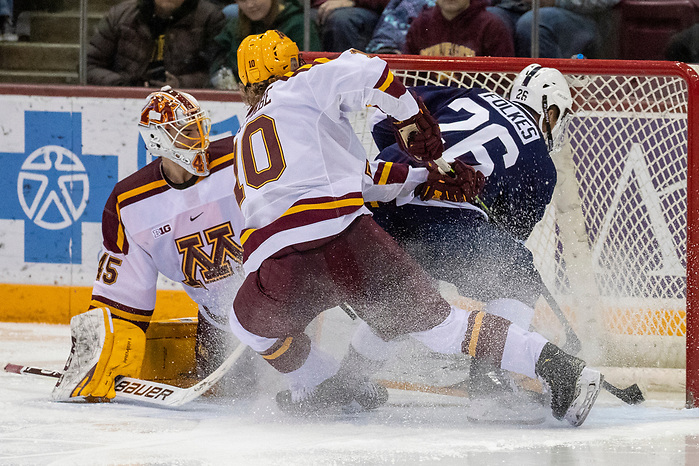
“Every play matters. Every shift matters.”
That’s the saying in the Michigan locker room over the door at the bottom of the stairs, just before the players exit to take the ice.
It’s something Mel Pearson repeated after the Wolverines lost to Michigan Tech in the title game of the Great Lakes Invitational tournament Dec. 31.
Pearson may have been talking about the game the Wolverines had just played, but the phrase is something that can be applied to the second half of the Big Ten season.
Every play. Every shift.
With six points separating first-place Penn State from fourth-place Notre Dame and both Ohio State and Michigan State tied a point ahead of the Fighting Irish, the Big Ten may be in for a big finish in the coming months.
No one is mathematically eliminated from capturing the regular-season title, but each of the top four teams controls its own destiny. Each can win the regular-season title and earn a first-round playoff bye outright with a magic number of wins, each separated by a single number: Penn State (11), Ohio State (12), Michigan State (13), Notre Dame (14).
The Nittany Lions have a single game against Robert Morris this weekend and return to conference play with a home series against Michigan Jan. 17-18. Penn State has lost back-to-back games once this season and has not been swept by a single opponent in a given weekend. In a sweep of Niagara last weekend, Penn State scored five total goals, prompting Guy Gadowsky to address a bit of an offensive identity crisis for the second time this season.
“For some reason, we are obviously in an offensive rut,” said Gadowsky. “This is new for us and we need to figure it out.”
So much of the Nittany Lions’ strategy is relentless, passionate offense, shooting from anywhere on the ice and at any time in the game. Last season, Penn State led the nation in offense, averaging 4.54 goals per game; this season, the Nittany Lions are third (3.90), and since a 3-2 overtime loss to UMass Lowell Nov. 30, Penn State is averaging 2.14 goals per game.
In four of the seven games in that stretch, the Nittany Lions were limited to two or fewer goals per game and were shut out once. In fact, they’ve been shut out three times this season after not having been shut out once in 2018-19 and twice the season before.
Penn State isn’t the only Big Ten team that is having difficulty scoring. Through their first 10 games of the season, the Fighting Irish went 9-1-0 and averaged 3.8 goals per game. Then came a seven-game winless streak (0-6-1) in which Notre Dame averaged 1.42 goals per game. Just before the midseason break, the Irish snapped out of it with a 3-0 win over Penn State and last weekend tied Western Michigan 1-1 before beating the Broncos 4-1.
“We’ve been getting opportunities to score, but we just haven’t finished,” said Notre Dame coach Jeff Jackson. “You hope that once guys start getting a goal here and there, they start getting their confidence back.”
Jackson points to senior Cam Morrison with three goals in his last four games and sophomore Alex Steves with four in his last four as two players who are regaining their confidence. Senior Cal Burke is one that has been in a rut. Burke scored a goal in each of the first four games of the season but none since.
“The biggest thing is that we need a couple seniors to get a goal to get the monkey off their backs, just like Cam Morrison,” said Jackson. “Once Cal Burke scores a goal – I told him last week, ‘The next goal you score is mostly likely going to be off your butt,’ and that’s probably what will happen. He needs to get a break. He’s playing hard.”
Jackson said that in addition to Notre Dame’s offense rebounding, netminding is also returning to form.
“The positive thing for us right now is that Cale Morris is starting to get his game back, and then we have to do a better job of trying to finish for him so that he doesn’t have to worry about getting a shutout in order to win a game,” said Jackson. “If we can start getting some timely scoring again, it will certainly help us.”
For Ohio State, consistency is key.
“We’ve got a long way to go,” said Buckeyes coach Steve Rohlik. “We’re far from the finished product. We’ve got a lot of room to grow, which is good and bad. Obviously, you want to get there, but sometimes it takes time.”
The Buckeyes have been more active than any other team since the end of the first half of the season, having swept visiting Colgate Dec. 27-28 before playing in the Fortress Invitational in Las Vegas last weekend. In that tournament, Ohio State lost a 5-2 game to Cornell before beating Army West Point 2-1 in overtime.
“We learned that we’ve still got to be consistent for 60 minutes,” said Rohlik. “We played two really good hockey teams and you’ve got to compete.”
Rohlik said that the fast start to the second half is both good and bad. The Buckeyes just returned from Las Vegas and are now headed to Wisconsin for a series this weekend. Ohio State plays eight of its remaining 14 games on the road.
“Bumped and bruised and guys out of the lineup and guys sitting behind, all those kinds of things affect you,” said Rohlik. “That’s the one thing. It’s nice that we’ve got games under our belt. We’ve got to be ready, at this time of year.”
The Spartans have a favorable schedule down the road, with eight games at home, one against Michigan at Little Caesars Arena in Detroit, and five more on the road.
“We haven’t had a lot of home games and we’ve been able to start building forward on that,” said Michigan State coach Danton Cole. “We’ve made it a bit of a tougher place to play. Our crowd’s been great. Hopefully we can keep that rolling. That bodes well for us if we take care of business here.”
Michigan State is a team that is rebuilding but doing so in front of senior goaltender John Lethemon, who is having a career season. Last year, Lethemon allowed 3.24 goals per game with a save percentage of .905; this year, he allows 2.06 goals per game with a .938 save percentage. Lethemon’s improved play has allowed the Spartans to be competitive in every game. While still not scoring a lot of goals – 2.60 per game this season to last year’s 2.75 – Michigan State is tough from end to end.
Cole is pleased.
“I think we’ve got an identity and I think the guys are comfortable with that,” said Cole. “I do like the way our guys react to [mistakes]. They don’t get panicked. They understand who they are. They keep going through the right process. They can push when they have to push.”
In returning to Big Ten play, the Spartans host Minnesota this weekend and Cole is aware of the bigger picture, too. Penn State and Ohio State are sixth and seventh, respectively, in the PairWise Rankings. Notre Dame is 14th and definitely on the bubble. At 16th, though, Michigan State is knocking on the door.
“We’ve got 14 Big Ten games, and they’re all going to be like playoff games,” Cole said. “We’re right on the edge of qualifying for the NCAA tournament. I think our guys are aware of that. We don’t spend a lot of time talking about it, but they know the implications of every game.”
Every Big Ten team has two games in hand on first-place Penn State. Minnesota is 11 points out of first place, Wisconsin is 16 behind Penn State and in last place, Michigan is 17 points behind the Nittany Lions.
Every shift, every play counts, but according to Rohlik, there’s one more thing as the second season progresses.
“Now,” said Rohlik, “it’s just about no regrets. No regrets in practice, no regrets during the week, no regrets on the weekend.”
Maybe the schedule doesn’t matter so much
One coach not concerned with where his team is playing is Minnesota’s Bob Motzko.
“If we win, it’s advantageous,” said Motzko. “It is what it is. I learned a long time ago to never worry about my schedules. It’s how you’re playing and how heathy you are.”
Motzko said that there is “some sickness going around” the Golden Gophers this week, but that Minnesota is starting the second half on a high after beating Bemidji State and Minnesota State to win the Mariucci Classic Dec. 28-29. The Gophers outscored opponents 9-3 in that tourney as well.
“Where we’re at right now, those were two big wins for us – huge wins for us,” said Motzko. “Where we’re at in the development process, you get a weekend like that, that was a big weekend. For us internally and how we’ve been battling through everything, we had to enjoy that. We had to feel good about that weekend. It’s a building block. It’s just where we’re at in our process.”
A an old rivalry
This weekend when Michigan heads to Notre Dame, the teams will be meeting for the 145th and 146th times in program history. It isn’t a rivalry that immediately comes to mind in the greater college hockey community but it’s one that fans of each team know well, one with its roots in football but also grounded in more local college hockey history.
“I think, for me it’s kind of carried over from our days in the CCHA and even carries over from my time at Lake Superior State,” said Jackson. “We’ve always had a rivalry with Michigan. The long history of Notre Dame and Michigan goes way back to the Knute Rockne era, so I don’t have to explain that to people. That’s where the development of that rivalry started, and it exists in all of our sports.”
Most college football fans know that Rockne coached at Notre Dame from 1918 to 1930. Perhaps not as well known, though, is that Rockne had an acrimonious relationship with Michigan coach Fielding H. Yost, who coached Michigan from 1901 to 1923 and then again for the 1925 and 1926 seasons, after which he served as the university’s athletic director until 1940.
“Obviously, football is where it gets the most press,” said Jackson, “but I think it was only a natural that we’d end up good rivals with Michigan. We’ve played them in a lot of big games over the years, whether it be conference championship or NCAA tournaments.
“That’s a sign of good programs, too. When you have two really good programs, those rivalries develop, and when you’re close geographically and with the history of the two schools, it’s created even that much more excitement around any time any of our sports play Michigan.”
Michigan is 78-61-5 all-time against Notre Dame – in hockey – and last season, the teams were 2-2-0 against each other.
In spite of where the Wolverines are in the standings, Mel Pearson thinks his team is poised to make some waves in the second half.
“We’re right there,” said Pearson. “We’ve been right there all year. We’ve got to find a way to win those games and make sure that the plays that matter are in our favor.
“Our staff really likes this team. I’m looking forward to the second half and I think we can do some real good things. Yes, we’ve made strides.”
The Irish are not taking the Wolverines for granted.
“There are no easy nights in the Big Ten,” said Jackson. “There are no easy nights in college hockey. Everybody you play is high talent level, high speed. Our conference is built around speed and skill for the most part. That’s going to be the key to the rest of the Big Ten play.”


